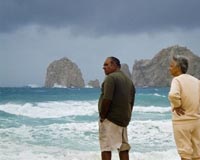| . |  |
. |
West Lafayette IN (SPX) Sep 02, 2009 If it has already rained, it's going to continue to pour, according to a Purdue University study of how ocean-origin storms behave when they come ashore. More than 30 years of monsoon data from India showed that ground moisture where the storms make landfall is a major indicator of what the storm will do from there. If the ground is wet, the storm is likely to sustain, while dry conditions should calm the storm. "Once a storm comes overland, it was unclear whether it would stall, accelerate or fizzle out," said Dev Niyogi, Indiana state climatologist and associate professor of agronomy and earth and atmospheric sciences. "We found that whether a storm becomes more intense or causes heavy rains could depend on the land conditions - something we'd not considered. Thus far we've looked at these storms based mainly on ocean conditions or upper atmosphere." Niyogi said tropical storms gain their strength from warm ocean water evaporation. "The same phenomenon - the evaporation from the ocean that sustains the storms - could be the same phenomenon that sustains that storm over land with moisture in the soil," he said. "The storm will have more moisture and energy available over wet soil than dry." Niyogi's team's findings were published in the August edition of the journal Geophysical Research Letters. Storm data fed into a model showed that higher levels of ground moisture would sustain Indian monsoon depressions. The model's prediction was proven when compared to ground conditions for 125 Indian monsoons over 33 years, where storms sustained when the ground was wet at landfall. Knowing the sustainability of a storm could lead to better predictions on flooding and damage inland before a monsoon or a hurricane makes landfall. "We think the physics is such that we could see similar results more broadly, such as in the United States," Niyogi said. The National Science Foundation and NASA funded the research. The Purdue led-team also consisted of researchers from the National Center for Atmospheric Research, NASA-GSFC/ESSIC, the University of Georgia, the Indian Space Research Organization and the Indian Institute of Technology Delhi. Niyogi said the next step is to use the model and ground moisture data to test these theories for hurricanes in the United States. Share This Article With Planet Earth
Related Links Purdue University Bringing Order To A World Of Disasters When the Earth Quakes A world of storm and tempest
 Tourists flee Hurricane Jimena in Mexico
Tourists flee Hurricane Jimena in MexicoPuerto San Carlos, Mexico (AFP) Sept 1, 2009 Hurricane Jimena sent tourists fleeing Tuesday as it bore down on Mexico's Baja California, while fishing communities on the sparsely populated peninsula toughed it out. The peninsula, which spears down from California into northwestern Mexico, lay directly in the path of 2009's mightiest hurricane, but few residents evacuated even as tourists scattered from resorts on its southern tip. ... read more |
|
| The content herein, unless otherwise known to be public domain, are Copyright 1995-2009 - SpaceDaily. AFP and UPI Wire Stories are copyright Agence France-Presse and United Press International. ESA Portal Reports are copyright European Space Agency. All NASA sourced material is public domain. Additional copyrights may apply in whole or part to other bona fide parties. Advertising does not imply endorsement,agreement or approval of any opinions, statements or information provided by SpaceDaily on any Web page published or hosted by SpaceDaily. Privacy Statement |